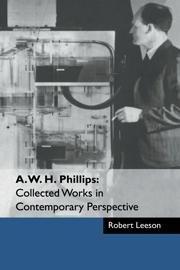Book contents
- Frontmatter
- Contents
- List of contributors
- Foreword by Arthur Brown
- Preface by Robert Leeson
- Part I Bill Phillips: Some Memories and Reflections
- Part II The Phillips Machine
- Part III Dynamic Stabilisation
- 15 The optimal control articles
- 16 Stabilisation policy in a closed economy
- 17 Stabilisation policy and the time-forms of lagged responses
- 18 Arnold Tustin's The Mechanism of Economic Systems: a review
- 19 Michel Kalecki's Theory of Economic Dynamics: An Essay on Cyclical and Long-Run Changes in the Capitalist Economy: a review
- 20 The growth articles
- 21 A simple model of employment, money and prices in a growing economy
- 22 Employment, inflation and growth
- 23 Economic policy and development
- 24 The famous Phillips Curve article
- 25 The relation between unemployment and the rate of change of money wage rates in the United Kingdom, 1861-1957
- 26 Discussion of Dicks-Mireaux and Dow's The Determinants of Wage Inflation: United Kingdom, 1946-1956
- 27 The Melbourne paper
- 28 Wage changes and unemployment in Australia, 1947-1958
- 29 Phillips and stabilisation policy as a threat to stability
- 30 The Phillips Curve in macroeconomics and econometrics
- 31 Bill Phillips' contribution to dynamic stabilisation policy
- 32 A Left Keynesian view of the Phillips Curve trade-off
- 33 Interactions with a fellow research engineer-economist
- 34 Does modern econometrics replicate the Phillips Curve?
- 35 The famous Phillips Curve article: a note on its publication
- Part IV Econometrics
- References
- Index of names
- Index of subjects
32 - A Left Keynesian view of the Phillips Curve trade-off
Published online by Cambridge University Press: 04 May 2010
- Frontmatter
- Contents
- List of contributors
- Foreword by Arthur Brown
- Preface by Robert Leeson
- Part I Bill Phillips: Some Memories and Reflections
- Part II The Phillips Machine
- Part III Dynamic Stabilisation
- 15 The optimal control articles
- 16 Stabilisation policy in a closed economy
- 17 Stabilisation policy and the time-forms of lagged responses
- 18 Arnold Tustin's The Mechanism of Economic Systems: a review
- 19 Michel Kalecki's Theory of Economic Dynamics: An Essay on Cyclical and Long-Run Changes in the Capitalist Economy: a review
- 20 The growth articles
- 21 A simple model of employment, money and prices in a growing economy
- 22 Employment, inflation and growth
- 23 Economic policy and development
- 24 The famous Phillips Curve article
- 25 The relation between unemployment and the rate of change of money wage rates in the United Kingdom, 1861-1957
- 26 Discussion of Dicks-Mireaux and Dow's The Determinants of Wage Inflation: United Kingdom, 1946-1956
- 27 The Melbourne paper
- 28 Wage changes and unemployment in Australia, 1947-1958
- 29 Phillips and stabilisation policy as a threat to stability
- 30 The Phillips Curve in macroeconomics and econometrics
- 31 Bill Phillips' contribution to dynamic stabilisation policy
- 32 A Left Keynesian view of the Phillips Curve trade-off
- 33 Interactions with a fellow research engineer-economist
- 34 Does modern econometrics replicate the Phillips Curve?
- 35 The famous Phillips Curve article: a note on its publication
- Part IV Econometrics
- References
- Index of names
- Index of subjects
Summary
I only met Bill Phillips four times. The first time was in the mid 1950s when he was the selected ‘heavy’ of the host economics department (LSE) who spoke at the Cambridge-London-Oxford research students seminar. As far as I can remember he gave a paper on feedback mechanisms in Marshallian supply and demand analysis. It was refreshingly lacking in respect for Marshall in particular and economists in general. Not that he was a show-off, it was just that he said what he thought and backed up any critique with hard-headed analysis of the sort he was accustomed to use for engineering problems. That was one of his greatest strengths.
The second time was in Adelaide in the late 1950s where he gave a paper on an Australian Phillips Curve (chapter 28), having recently pub- lished the Phillips Curve itself (chapter 25). His paper was only a first draft but it was so criticised and dissected by Eric Russell in particular that it never saw the light of day in the public domain. In this instance his engineering background was a weakness, for he seemed inclined to take economic statistics as gospel, that is, that they actually meant something really precise. Eric, of course, knew the Australian statistics on wages, employment and prices intimately and was able to show that the data were so non-homogenous as to make completely unsound any attempt to fit a curve to them. Even if there were to be an underlying relationship to be teased out of the figures, they were just not in a form, and nor could they be put in one, to allow this procedure to occur.
- Type
- Chapter
- Information
- A. W. H. Phillips: Collected Works in Contemporary Perspective , pp. 304 - 307Publisher: Cambridge University PressPrint publication year: 2000
- 5
- Cited by



